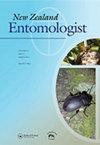Mass rearing and release of Mastrus ridens (Hym: Ichneumonidae) a parasitoid for the biological control of codling moth Cydia pomonella.
IF 0.4
4区 农林科学
Q4 ENTOMOLOGY
引用次数: 6
Abstract
ABSTRACT Mastrus ridens (Horstmann) (Hymenoptera: Ichneumonidae) was imported into New Zealand quarantine from Argentina in 2009 as a potential biocontrol agent for codling moth (CM), Cydia pomonella (L.) (Lepidoptera: Tortricidae). A laboratory population of M. ridens had been maintained at the New Zealand Institute for Plant and Food Research Limited in Auckland since 2009 on diapausing CM cocooned in corrugated cardboard rolls. Following government approval, large numbers of the parasitoids were released into apple growing regions in New Zealand over a period of 5 years from 2012 to 2017. The mass rearing system needed for these releases was managed to avoid bacterial infections and to maintain the fitness of the release insects. Nearly 243,000 adult M. ridens were released into 35 sites across Hawke’s Bay, Gisborne, Nelson, Central Otago, Waikato, Wairarapa and 17 sites in greater Auckland. We selected release sites that were abandoned or poorly managed commercial blocks of apples, or ‘home-garden’ orchards with mature apple, walnut or pear trees, without insecticide sprays. Most releases were made during the period between January and March when there was an abundance of flowering plants (mostly weeds) present, providing a local source of nutrition for the adult parasitoids, and cocooning CM larvae were likely to be present. Mastrus ridens adults were frequently seen at many release sites in late summer providing early evidence of establishment.大规模饲养和释放Mastrus ridens(Hym:Icheneumonidae),这是一种用于生物防治尾蛾Cydia pomonella的寄生蜂。
摘要Mastrus ridens(Horstmann)(膜翅目:伊蚊科)于2009年从阿根廷进口到新西兰检疫,作为一种潜在的毒蛾(CM)、绒球蛾(Cydia pomonella)(鳞翅目:毒蛾科)的生物防治剂。自2009年以来,奥克兰的新西兰植物和食品研究所有限公司一直在对包裹在瓦楞纸板卷中的CM进行滞育,并对其进行了实验室种群管理。在政府批准后,从2012年到2017年的5年时间里,大量的寄生蜂被释放到新西兰的苹果种植区。对这些释放所需的大规模饲养系统进行了管理,以避免细菌感染并保持释放昆虫的健康。霍克湾、吉斯伯恩、纳尔逊、奥塔哥中部、怀卡托、怀拉拉帕的35个地点和大奥克兰的17个地点共释放了近24.3万只成年M.ridens。我们选择了废弃或管理不善的商业苹果园,或有成熟苹果树、核桃树或梨树的“家庭花园”果园,没有喷洒杀虫剂。大多数释放是在1月至3月期间进行的,当时有大量的开花植物(主要是杂草),为成虫提供了当地的营养来源,并且可能存在结茧的CM幼虫。在夏末的许多放生点经常看到成年Mastrus ridens,这为其建立提供了早期证据。
本文章由计算机程序翻译,如有差异,请以英文原文为准。
求助全文
约1分钟内获得全文
求助全文
来源期刊

New Zealand Entomologist
ENTOMOLOGY-
CiteScore
0.70
自引率
33.30%
发文量
3
审稿时长
>12 weeks
期刊介绍:
The invertebrate diversity of New Zealand is of great interest worldwide because of its geographic isolation and geological history. The New Zealand Entomologist plays an important role in disseminating information on field-based, experimental, and theoretical research.
The New Zealand Entomologist publishes original research papers, review papers and short communications. We welcome submissions in all aspects of science regarding insects and arthropods in a New Zealand or Australasian setting. The journal’s subject matter encompasses taxonomy, phylogenetics, biogeography, biological control and pest management, conservation, ecology and natural history.
The journal is the official publication of the Entomological Society of New Zealand. Papers published or submitted elsewhere for publication will not be considered, but publication of an abstract or summary elsewhere (e.g. conference proceedings) does not preclude full publication in the New Zealand Entomologist. Accepted papers become copyright of the Entomological Society of New Zealand. The journal is published in English, but we also welcome publication of abstracts in Maori.
 求助内容:
求助内容: 应助结果提醒方式:
应助结果提醒方式:


